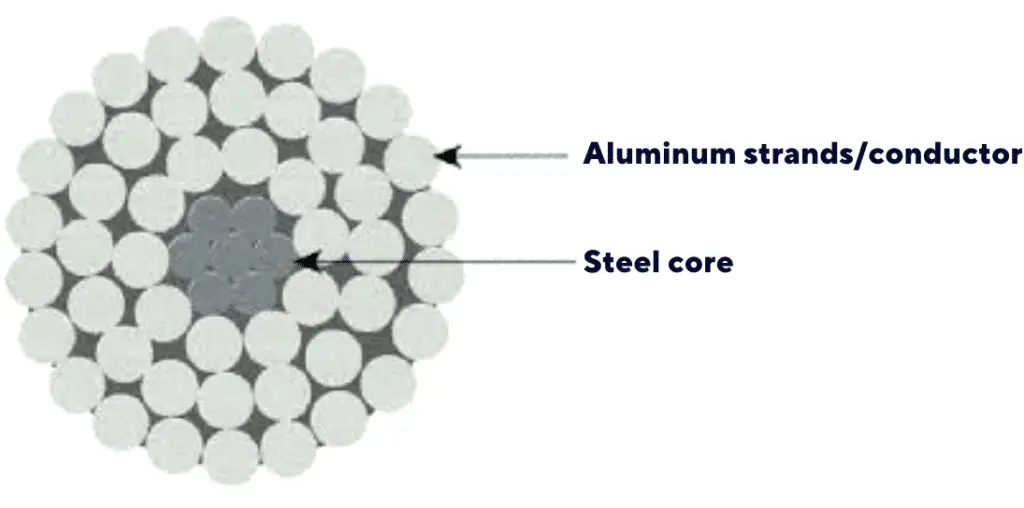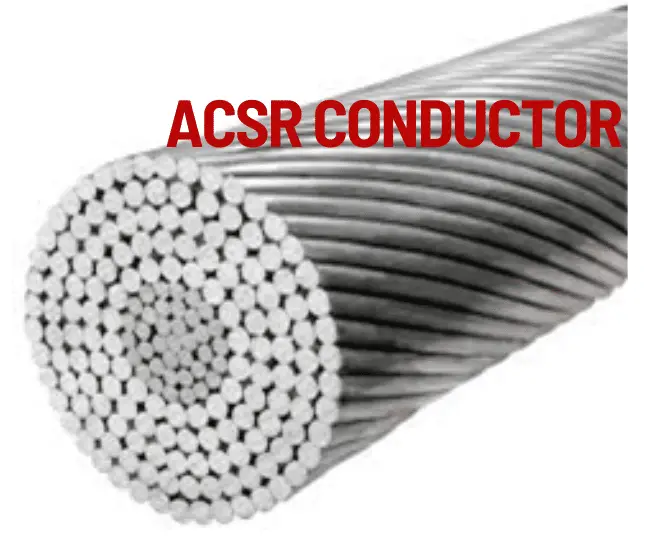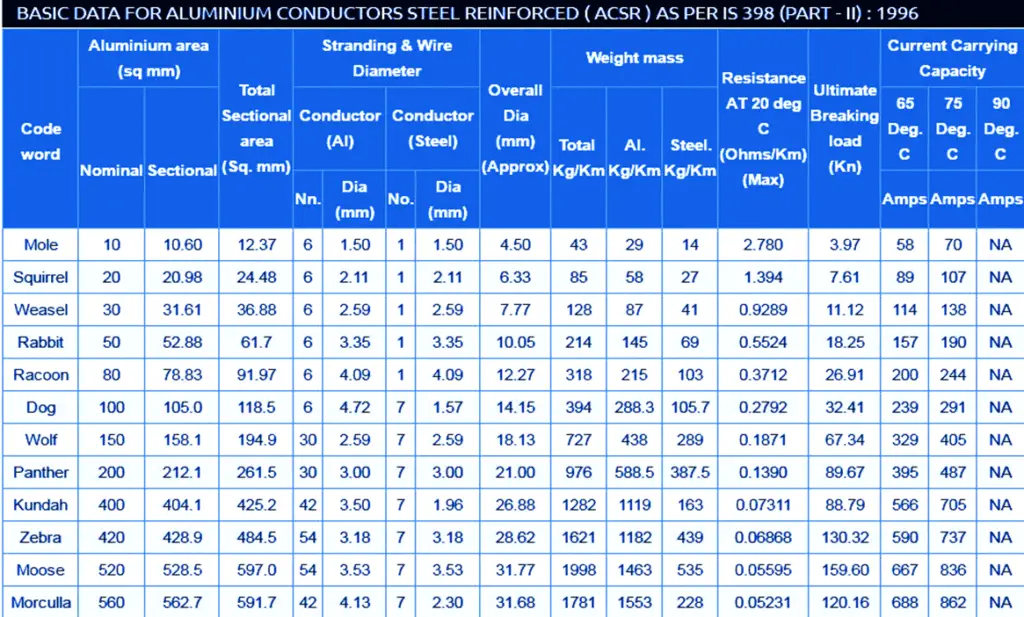The ACSR stands for Aluminum Conductor Steel Reinforced is a type of stranded conductor widely used in high voltage power transmission lines. It has a number of aluminum conductor layers on a stimulated steel wire core.
Overhead transmission lines or distribution lines play a very prominent role in the efficient working of the entire power system. The entire purpose of building a robust and efficient power system will stand defeated if the transmission infrastructure is not reliable and up to the mark. Hence, proper design and maintenance of transmission lines are crucial. One such reliable transmission line is the ACSR conductor.
ACSR stands for Aluminum Conductor Steel Reinforced conductors. It is a type of electrical cable that is commonly used for overhead power transmission and distribution lines. ACSR conductor is made up of a central steel core surrounded by one or more layers of aluminum wire. It is a type of stranded conductor.
How ACSR conductors came into Existence?
As we all know that copper happens to be one of the best conductors of electricity and is known for its durability. Hence, copper was the natural choice for manufacturing transmission lines.
However, the copper transmission line was not reliable as copper has a huge weight of itself for the same resistance value as compared to other metals like Aluminum. This caused a problem as the required support structure like cross-arms got costlier. In addition to that, copper transmission lines are used to create unwanted sag. Moreover, copper itself is costly which increases the initial cost of the entire project.
Thus copper was replaced with a lighter metal called Aluminum which provides good conductivity and has a low weight per unit distance and hence required a lower initial cost. It solved the sag problem as well. However, being a light metal, the tensile strength of the aluminum conductor is low. The tensile strength of the line is required so that it keeps working satisfactorily in all weathers.
Here came the role of Aluminum Conductor Steel Reinforced (ACSR). As the acronym says, it has a steel core that provides the cable with the necessary tensile strength and the core is surrounded by aluminum conductors through which the electrical power is transmitted. Aluminum has lower power loss which therefore increases the efficiency of the system. Thus, ACSR conductors are now widely used.
ACSR Conductor Design

The picture given above is of the ACSR conductors. As explained earlier, Aluminum Conductor Steel Reinforced (ACSR) conductors have a central core that has steel strands. This central steel core is surrounded by aluminum strands that transmit the power from one point to the other.
The aluminum conductor is of low weight per unit distance and it is economical. However, it has less tensile strength to support its own weight and works reliably all around the year. Thus, the strength of the line is increased by providing it with a central steel core, and hence the word “Reinforced” is used. The steel core provides the necessary tensile strength to the transmission line.
Making of an ACSR conductor
The ACSR conductor is designed in accordance with the voltage requirement. The conductor design for a certain voltage is indicated in x/y form, where x indicates the number of aluminum conductors while y indicates the number of steel strands. It goes without saying that x is always greater than y i.e, the number of aluminum conductors is going to be greater than that of the number of steel conductors or strands at the core.
For example: For an 11kV transmission line, the ACSR conductor of design 7/1 is required which means the number of aluminum conductors required is 7 while the number of steel strands required is 1.
Similarly, there are different designs like 12/7, 36/1, 26/7, etc. The diameter of both aluminum and steel strands is almost equal and the overall diameter of the ACSR conductor is calculated by considering the diameter of both the steel and the aluminum strands.

The diameter of the conductor plays an important role in the design of the conductor. A greater diameter may allow the flow of more current as the resistance of the conductor which is inversely proportional to the cross-sectional area of the conductor goes down. However, the disadvantage is the increased cost of manufacturing and that of the support structures like cross-arms as they have to hold weigher lines now.
In addition to that, the sag of the line increases as well which is undesirable. Also, a huge current flow causes the power factor to go down significantly, and thus the Active power which is the cosine component of the apparent power goes down and definitely this is undesirable.
Therefore, the only way to transmit bulk power from generating station to the distribution end followed by the consumers is by boosting the voltage level. As the electrical power transmitted is fixed and is directly proportional to both Voltage and current, increasing the voltage level reduces the burden on the current to transmit the power efficiently. Therefore, the level of the current reduces and this causes the cross-sectional area or the diameter of the conductor to reduce. This is desirable as it is both cost-effective and efficient.
Let’s take an example: An ACSR conductor to be used for an operating voltage of 66/132kV has a current-carrying capacity of 480A at a temperature of about 75 deg.C. For this conductor, the number of aluminum strands required is 54 with 7 number of steel strands at the core. The diameter of each aluminum as well as the steel strand is 3.15mm. The overall diameter of the conductor becomes 2.86 cm and its weight is about 1.62 kg/m.
The following table gives various data for each type of ACSR conductor.

ACSR Conductor Types
Here are some Types of ACSR Conductors:-
| Type | Acronym for |
| AAC | All Aluminium Conductor |
| AAAC | All Aluminium Alloy Conductor |
| ACSR | Aluminium Conductor Steel Reinforced |
| ACCR | Aluminium Composite Core Reinforced |
| ACCC | Aluminium Carbon Composite Core |
Properties of ACSR Conductors
High Strength
ACSR conductors are made up of high-strength steel wires that provide excellent tensile strength and mechanical support. The steel core also helps to minimize the thermal expansion and contraction of the conductor.
Low Weight
The outer layer of the ACSR conductor is made of aluminum, which has a lower density than steel. This makes the ACSR conductor lighter than an all-steel conductor of the same strength.
Good Conductivity
Aluminum is an excellent conductor of electricity, and the ACSR conductor has a high conductivity that allows it to transmit electrical energy efficiently over long distances.
Cost-effective
ACSR conductors are less expensive than some other types of conductors, such as all-aluminum conductors.
Corrosion Resistance
Aluminum has excellent corrosion resistance, and this property is essential for ACSR conductors that are exposed to outdoor elements.
Longevity
ACSR conductors have a long life span because of their high-strength steel core and corrosion-resistant aluminum outer layer.
Easy installation
ACSR conductors are easy to install because of their lightweight and high strength. They can be strung between poles or towers with minimal effort.
Flexibility
ACSR conductors have some flexibility that allows them to withstand the wind and other external forces without breaking.
Skin Effect
ACSR conductors have a high-conductivity aluminum layer, which means that the current tends to flow through the outer layer of the conductor. This is known as the skin effect, and it can result in increased resistance and heating of the conductor.
Proximity Effect
The proximity effect is another phenomenon that occurs in ACSR conductors when two or more conductors are placed close to each other. The current flowing through one conductor induces a magnetic field that affects the current flow in the nearby conductors, resulting in an increase in resistance and heating of the conductors.
Corona Loss
When ACSR conductors are operated at high voltages, they can experience corona losses. Corona is a phenomenon where the electric field around the conductor ionizes the air, creating a small amount of electrical discharge. This discharge causes energy loss and can result in increased noise and interference in communication systems.
Mechanical Properties
ACSR conductors are designed to withstand mechanical stress, such as wind, ice, and seismic events. The steel core provides high tensile strength, while the aluminum layer provides flexibility and allows the conductor to expand and contract with temperature changes.
Electrical Properties
ACSR conductors have high electrical conductivity, which allows them to transmit electrical energy efficiently over long distances. The conductor design can also be optimized for specific electrical properties, such as resistance, reactance, and impedance.
Disadvantages of ACSR conductors
Corrosion
Although aluminum has excellent corrosion resistance, it can still corrode over time, especially in harsh environments. This can reduce the lifespan of the conductor and increase maintenance costs.
Higher cost than all-aluminum conductors
ACSR conductors are less expensive than some other types of conductors, such as all-copper conductors, but they are generally more expensive than all-aluminum conductors.
Installation challenges
ACSR conductors require skilled personnel and specialized equipment for installation and maintenance, which can add to the cost and time required for installation.
Difficult to repair
If a section of the ACSR conductor is damaged, it can be challenging to repair or replace it without disrupting the entire system.
Susceptible to theft
ACSR conductors have a high value and can be stolen for their scrap value, causing disruptions in power transmission and distribution systems.
Limited flexibility
While this Types of ACSR Conductor have some flexibility, they are not as flexible as some other types of conductors, which can make them less suitable for some applications.